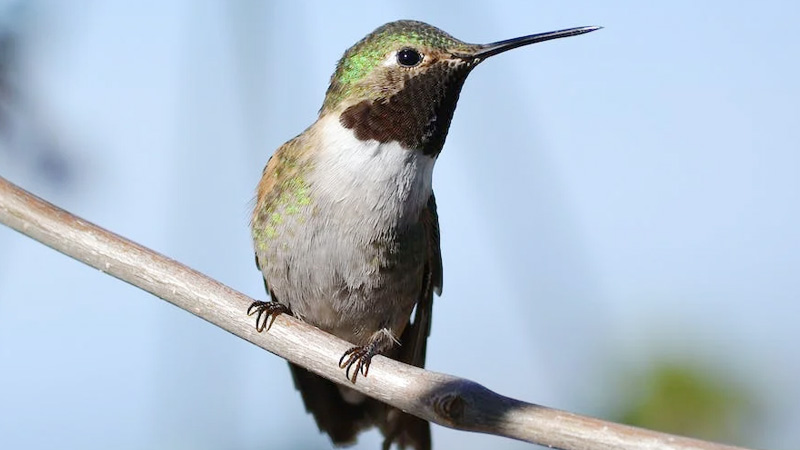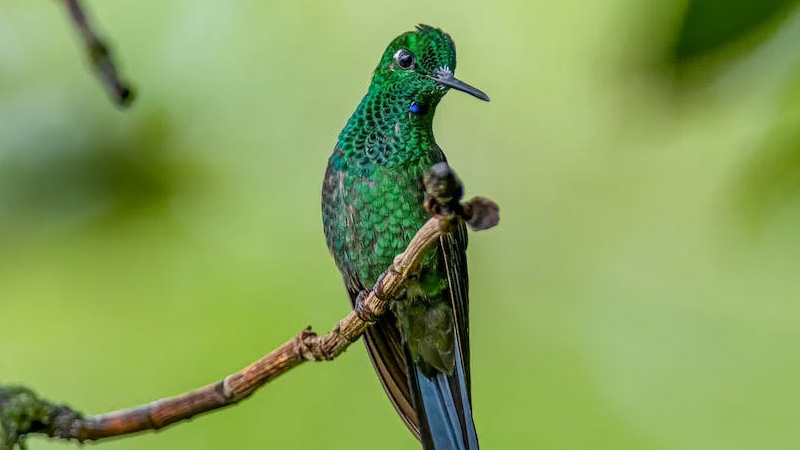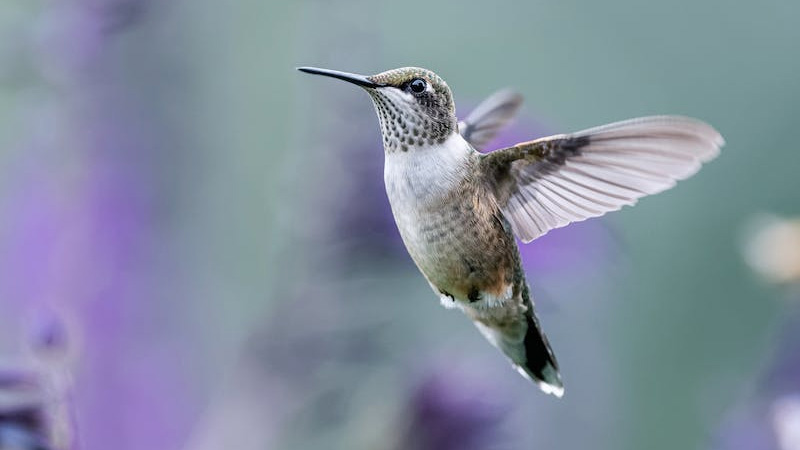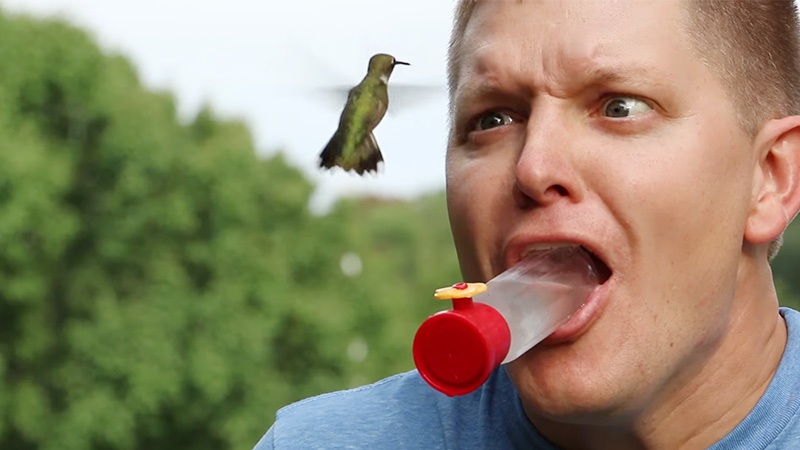Hummingbirds, with their vibrant plumage and lightning-fast wings, have always fascinated humans. These tiny, agile creatures possess a curiosity that often leads them to observe humans and their surroundings.
If you’ve ever had the opportunity to witness a hummingbird staring directly at you, you may have wondered about the motivation behind its intense gaze. In this article, we will explore the possible reasons why do hummingbirds stare at you.

Why Do Hummingbirds Stare at You?
Below are the possible reasons why hummingbirds stare at people:
Curiosity and Adaptability
Hummingbirds are naturally inquisitive creatures. With their keen eyesight and exceptional visual acuity, they are quick to notice any movement in their environment.
When a hummingbird encounters a human, it may be captivated by the novelty of the encounter. The unique characteristics of human beings, such as size, shape, and movements, might pique their curiosity, leading to prolonged periods of observation.
Recognition and Associative Learning
While it is unclear whether hummingbirds possess the ability to recognize individual humans, they can certainly associate certain actions with potential rewards.
If you regularly provide a food source for hummingbirds, such as a feeder or a garden with nectar-rich flowers, they might learn to associate your presence with a reliable source of sustenance.
Establishing Territory and Asserting Dominance

Hummingbirds are fiercely territorial creatures, especially during the breeding season. Males, in particular, engage in territorial disputes to protect their chosen feeding and nesting areas.
When a hummingbird stares at you, it could be interpreting your presence as a potential threat to its territory. By locking eyes with you, it may be asserting its dominance and communicating that you are encroaching upon its domain.
Courtship and Mating Behavior
During the mating season, male hummingbirds engage in elaborate displays to attract females. These displays often involve intricate aerial maneuvers and flamboyant plumage exhibitions.
While staring at you, a male hummingbird might mistake your movements or colors as a rival competitor. It could be sizing you up to determine whether you pose a threat to its courtship efforts.
Visual Reflections and Mirror-like Surfaces
Another possible reason for a hummingbird’s gaze fixation is the presence of reflective surfaces or objects. Hummingbirds have an affinity for bright colors and shiny objects, often mistaking them for sources of nectar.
If you are wearing something reflective or if you have reflective objects nearby, a hummingbird may simply be transfixed by the reflected light, unaware that it is staring directly at you.
Why Do Hummingbirds Fly Up to Your Face?

When a hummingbird flies up to your face, it can be a captivating and exhilarating experience. While the specific reasons for this behavior may vary, there are a few possible explanations for why hummingbirds might approach you in such a manner:
Curiosity and Exploration
Hummingbirds are naturally curious creatures and may be intrigued by the sight and sound of a human face. Your face might appear interesting and different to them, leading them to investigate and explore their surroundings.
This behavior is particularly common when you are wearing bright or colorful clothing, as hummingbirds are drawn to vibrant hues.
Mistaking You for a Flower
Hummingbirds are primarily attracted to flowers because they provide them with nectar, their primary food source. If you are wearing colorful clothing or have bright accessories, a hummingbird might mistake you for a large, stationary flower.
Their instinctual response would be to investigate and attempt to feed from what they perceive as a potential nectar source.
Asserting Dominance or Territory
During the breeding season, male hummingbirds engage in territorial displays to defend their chosen feeding and nesting areas. If a hummingbird perceives you as an intruder in its territory, it might approach you aggressively to establish dominance and protect its domain.
This behavior is more likely if the bird perceives you as a potential threat or if you are in close proximity to its nesting site or preferred food sources.
Courtship and Mating Behavior
Male hummingbirds display elaborate courtship rituals to attract females. These displays often involve intricate aerial maneuvers and visual presentations of their colorful plumage.
If a male hummingbird perceives you as a potential rival for the attention of a female, it might fly up to your face as part of its courtship behavior, attempting to assert its dominance and deter competition.
Reflections and Shiny Objects
Hummingbirds are attracted to reflective surfaces and shiny objects, as they resemble the glimmering appearance of nectar-filled flowers. If you are wearing jewelry or have any reflective objects on your person, a hummingbird might be drawn to them, resulting in its approach to your face.
It’s important to note that these behaviors can vary among individual hummingbirds, and not all hummingbirds will exhibit the same tendencies. Additionally, factors such as the bird’s age, experience, and environmental conditions can influence its behavior.
If a hummingbird flies up to your face, it’s generally best to remain calm and still to avoid startling or stressing the bird. Enjoy the unique opportunity to observe these fascinating creatures up close and appreciate the beauty of their inquisitive nature.
Can You Prevent the Hummingbird Attacks?

While hummingbird attacks are not common, there are steps you can take to minimize the likelihood of such encounters, especially during the breeding season when territorial behavior is heightened. Here are some tips to help prevent hummingbird attacks:
Provide Multiple Feeding Stations
If you have hummingbird feeders in your yard, consider placing them at various locations instead of clustering them in one area. This will allow hummingbirds to establish their own territories and reduce the chances of aggressive interactions between individuals.
Increase Feeder Placement
Space out your feeders to create distance between them. By spreading out the food sources, you provide more opportunities for hummingbirds to find sustenance without feeling the need to aggressively defend a single feeder.
Use Red Decorations
Hummingbirds are attracted to the color red, which mimics the vibrant hues of flowers that provide nectar. By hanging red ribbons, flags, or other decorations near your feeders, you can divert their attention away from potential intruders, reducing territorial aggression.
Diversify Feeder Locations
Place feeders near natural cover, such as trees or shrubs, to give hummingbirds nearby perches to rest and observe their surroundings. This helps reduce their stress levels and decreases the likelihood of aggressive encounters.
Increase the Number of Feeders
Adding more feeders can help distribute feeding opportunities among a larger hummingbird population. This can reduce competition and territorial aggression, as each bird has access to its own feeding station.
Adjust Feeder Placement
If you notice a particular hummingbird constantly attacking others near a feeder, try moving the feeder to a different location. Changing the sightlines and angles can disrupt territorial boundaries and discourage aggressive behavior.
Plant Natural Food Sources
To reduce the dependence on feeders and encourage more natural foraging behavior, create a hummingbird-friendly garden with a variety of nectar-rich flowers. This provides an alternative food source and helps to disperse hummingbirds throughout the area, reducing conflicts.
Wear Neutral Colors
If you find yourself repeatedly targeted by a territorial hummingbird, try avoiding bright or floral-patterned clothing. Neutral colors are less likely to trigger aggressive responses from hummingbirds that mistake them for potential rivals.
Maintain Distance and Stay Still
If a hummingbird displays aggressive behavior towards you, such as dive-bombing or hovering close to your face, it is best to stay calm and still.
Avoid making sudden movements or swatting at the bird, as this may escalate the situation. Eventually, the bird will likely lose interest and move on.
Remember, hummingbird attacks are rare, and these tips are primarily precautionary measures. Enjoy observing these fascinating creatures from a respectful distance, and they will continue to bring joy with their acrobatic displays and enchanting presence in your garden.
Do Hummingbirds Recognize Certain Humans?
While hummingbirds have excellent visual memory and can recognize specific features of their environment, including landmarks and preferred feeding locations, it is unclear whether they can recognize and differentiate between individual humans.
Hummingbirds have relatively small brains, and their cognitive abilities are not extensively studied. However, hummingbirds can associate certain actions with rewards, such as humans providing a consistent food source, like a feeder or a garden with nectar-rich flowers.
They can learn to recognize and remember these food sources, associating them with a positive outcome. If you regularly provide a reliable food supply for hummingbirds, they may become accustomed to your presence and associate you with a source of nourishment.
That said, the extent of their recognition of humans as individuals is uncertain. It is more likely that they recognize patterns, behaviors, or the environment associated with a positive experience, rather than recognizing specific human faces or identities.
It is essential to approach hummingbirds with respect and observe them from a comfortable distance, allowing them to go about their natural behaviors without unnecessary disruption.
Enjoy the privilege of their visits and provide them with a welcoming environment, and they will continue to grace your garden with their presence.
FAQs
Hummingbirds have incredibly rapid wingbeats. On average, they beat their wings around 50 to 80 times per second during normal flight. However, during courtship displays and high-speed flights, they can exceed 200 wingbeats per second.
The lifespan of a hummingbird can vary depending on the species. On average, hummingbirds live for about 3 to 5 years in the wild.
However, some larger species have been known to live up to 10 years or more. Factors such as habitat, predation, disease, and availability of food sources can influence their lifespan.
Hummingbirds feed primarily on nectar from flowers. They use their long, slender bills to reach into the depths of flowers and extract the nectar. They also have specialized tongues that can extend deep into flowers and lick up the sweet nectar.
Hummingbirds are known for their remarkable long-distance migrations. They have the ability to fly hundreds or even thousands of miles during their migratory journeys.
To prepare for migration, they undergo a period of hyperphagia, where they consume large amounts of food to build up fat reserves.
Hummingbirds typically lay small clutches of eggs. The exact number of eggs can vary by species, but most hummingbirds lay between one to three eggs per clutch. The female incubates the eggs and raises the chicks on her own.
Final Words
So, now you know why do hummingbirds stare at you. Hummingbirds possess a range of complex behaviors and motivations that make them captivating creatures to observe.
While their staring behavior might not always have a clear explanation, it often stems from their curiosity, associative learning, territorial instincts, courtship rituals, or the allure of reflections.
As we continue to study and appreciate these delightful birds, their behavior will undoubtedly continue to inspire awe and intrigue among nature enthusiasts worldwide.
So, the next time you catch a hummingbird’s unwavering gaze, take a moment to appreciate the fascinating world of these tiny, mesmerizing creatures.